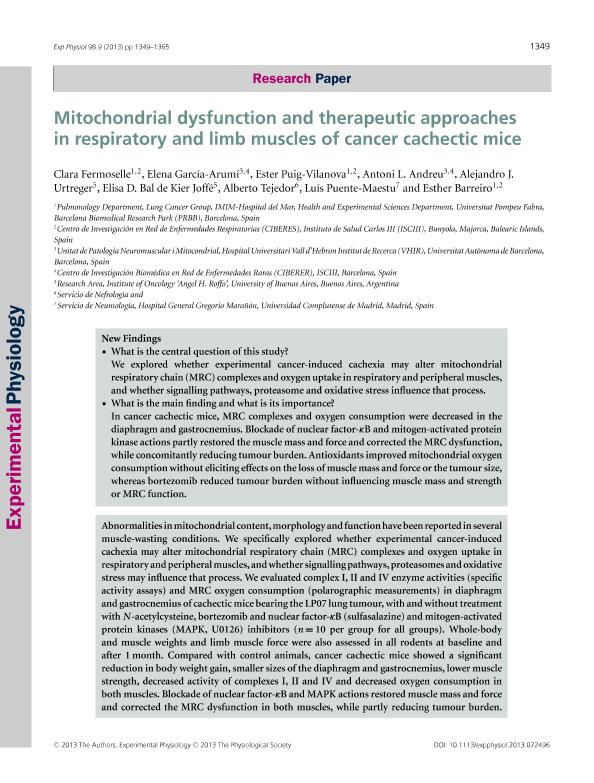Artículo
Mitochondrial dysfunction and therapeutic approaches in respiratory and limb muscles of cancer cachectic mice
Fermoselle, Clara; García Arumí, Elena; Puig Vilanova, Ester; Andreu, Antoni L.; Urtreger, Alejandro Jorge ; Bal, Elisa Dora
; Bal, Elisa Dora ; Tejedor, Alberto; Puente Maestu, Luís; Barreiro, Esther
; Tejedor, Alberto; Puente Maestu, Luís; Barreiro, Esther
 ; Bal, Elisa Dora
; Bal, Elisa Dora ; Tejedor, Alberto; Puente Maestu, Luís; Barreiro, Esther
; Tejedor, Alberto; Puente Maestu, Luís; Barreiro, Esther
Fecha de publicación:
09/2013
Editorial:
Wiley
Revista:
Experimental Physiology.
ISSN:
0958-0670
Idioma:
Inglés
Tipo de recurso:
Artículo publicado
Clasificación temática:
Resumen
Abnormalities in mitochondrial content, morphology, and function were reported in several muscle wasting conditions. We specifically explored whether experimental cancer-induced cachexia may alter mitochondrial respiratory chain (MRC) complexes and oxygen uptake in respiratory and peripheral muscles, and whether signaling pathways, proteasome, and oxidative stress may influence that process. We evaluated complex I, II, and IV enzyme activities (specific activity assays) and MRC oxygen consumption (polarographic measurements) in diaphragm and gastrocnemius of cachectic mice bearing the LP07 lung tumor with and without treatment with N-acetylcysteine, bortezomib, and nuclear factor (NF)-kB (sulfasalazine) and mitogen-activated protein kinases (MAPK, U0126) inhibitors, n=10/group, all groups. Whole body and muscle weights and limb muscle force were also assessed in all rodents at baseline and after one month. Compared to controls, cancer cachectic mice showed a significant reduction in body weight gain, smaller sizes of diaphragm and gastrocnemius, lower muscle strength, and decreased activity of complexes I, II, and IV, and oxygen consumption in both muscles. Blockade of NF-kB and MAPK actions restored muscle mass loss and force, and MRC dysfunction in both muscles, while partly reducing tumor burden. Antioxidants improved mitochondrial oxygen uptake without eliciting significant effects on muscle mass loss and force or tumor size, whereas the proteasome inhibitor reduced tumor burden without significantly influencing muscle mass and strength or mitochondrial function. In conclusion, NF-kb and MAPK signaling pathways modulate muscle mass and performance and MRC function of respiratory and limb muscles in this model of experimental cancer cachexia, thus offering targets for therapeutic intervention.
Archivos asociados
Licencia
Identificadores
Colecciones
Articulos(OCA HOUSSAY)
Articulos de OFICINA DE COORDINACION ADMINISTRATIVA HOUSSAY
Articulos de OFICINA DE COORDINACION ADMINISTRATIVA HOUSSAY
Citación
Fermoselle, Clara; García Arumí, Elena; Puig Vilanova, Ester; Andreu, Antoni L.; Urtreger, Alejandro Jorge; et al.; Mitochondrial dysfunction and therapeutic approaches in respiratory and limb muscles of cancer cachectic mice; Wiley; Experimental Physiology.; 98; 9; 9-2013; 1349-1365
Compartir
Altmétricas



